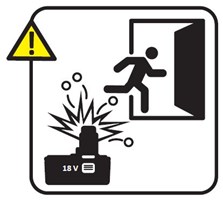Fire safety for e-bikes, e-scooters, cordless power tools, and other large portable devices
Large portable electrical devices powered by lithium-ion batteries

Download Lithium-ion Battery Safety - Large Portable Batteries PDF
Fire Safety for e-bikes, e-scooters, cordless power tools, electric outboards, and battery-powered water toys
Fire services are reporting a rise in ferocious fires that can spread quickly out of control, caused by damaged or failing lithium-ion batteries on e-bikes and e-scooters.
Because of their flexibility and convenience, we predict more boaters will be using lithium-ion powered e-bikes, e-scooters, cordless power tools, electric outboards, e-foils and similar electric water toys.
But along with all the potential benefits such products offer, new risks must be managed so boaters can enjoy their safe use. Don’t risk your boat or your life.
Keep all escape routes clear at all times, lithium-ion battery fires can spread rapidly and traditional fire extinguishers may not work.
If a battery or device starts making loud popping, hissing or screaming sounds, or emits toxic vapours/smoke, or catches fire, raise the alarm, warn others, get out, stay out and call 999/ch16 for help immediately.
How to Stay Safe – 10 Top Tips for Large Portable Equipment
|
1. Install/Test Smoke Alarms
Fit suitable, certified and working smoke alarms. Ensure they can be heard throughout the boat. Test them monthly.
2. Create a Safe-Escape Plan
Everyone aboard must know and understand how to act in case of an emergency.
|
 |
|
3. Monitor Charging Times
Keep an eye on the charging times and disconnect the device once fully charged. Consider using timers as reminders to unplug chargers.

4. Charge and Store Devices Outside the Vessel
Whenever possible, charge and store large portable items outside the cabin. If the battery is detachable, charge the battery outside.
|
5. Allow Batteries to Cool
After use, let batteries cool down before recharging. They can become warm during use and charging them immediately could lead to overheating.
6. Keep Watch During Charging
Always keep a close eye on anything on charge. Be aboard, awake and alert during the charging process, especially with larger capacity batteries used in DIY tools, e-bikes and e-scooters.
7. Inspect for Damage Regularly
Damage to batteries can cause self-combustion so regularly check for damage. Do not use or charge any damaged batteries or devices. Recycle them responsibly.

|
|
8. Protect Batteries from Damage
Be mindful when transporting and using your devices. Batteries and charging circuits can be easily damaged by bounces, bashes and bumps.
9. Dispose of Damaged Batteries Safely
Never dispose of damaged or end-of-life batteries in household waste. Follow local authority guidance on safe disposal.
10. Watch Out for Warning Signs
Know the critical warning signs of battery failure. If any are happening, turn off the power. Do not use it again and seek help from the supplier or manufacturer:
- Performance Issues: Longer charge times, incomplete charging, or failing charge indicators
- Excessive Heat: Batteries that feel extremely hot to touch
- Bulging/Leaking: Bulging batteries, odd lumps, or liquid/gas leaking from devices
- Smell: A strong or unusual smell can indicate that the battery is failing
|
If these warning signs are happening, get out and get off the boat (see tips 1 & 2)

- Noise: Popping, hissing, or screaming sounds.
- Smoke: Any smoke indicates an active fire.
|





